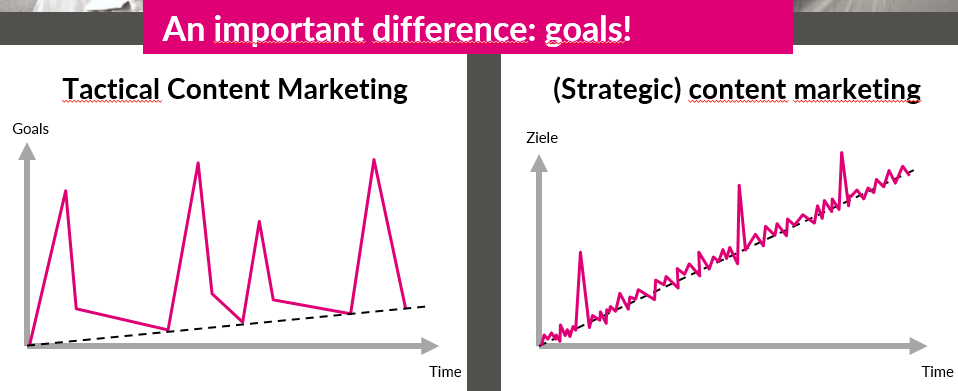Content marketing cannot be implemented overnight… it’s a change management process, especially if we are talking about a strategic approach. In this post I want to explain why and introduce you to a 3 step model you can use for getting everyone on board.
In the last couple of years, I have worked on various content marketing projects: whether it’s campaigns, strategy workshops or coachings on content operations (processes & tools). It has been incredibly interesting and rewarding to work on so many of them with different scopes. Over the years, I have come to realize that there an important aspect that few people realize when they start the journey.
Why (strategic) content marketing entails a change management process
Before anything we need to differentiate two „types“ of content marketing. Since everyone seems to be talking about the subject these days, there are a lot of different perspectives on what it actually is.
I have talked to a lot of different people with different backgrounds, with different roles and different objectives regarding what we all call „content marketing“. One takeaway is that there are misunderstandings because everyone views it from their own perspective. This picture pretty much shows what’s happening (and why many debates are going nowhere)…

(does anyone know the original author / source? I couldn’t find it…)
There is a fundamental and important difference to make to clarify what we are actually talking about.
- Instrumental or „tactical“ content marketing is using content to achieve short term, often campaign-based goals and initiated by a department in order to achieve a very specific set of measurable goals (generating leads, improving rankings, etc.).
- (strategic) content marketing is an approach that focuses on strategic communication goals like becoming a thought leader, improving brand awareness, improving brand sentiment, improving customer loyalty etc. This implies a long term approach and a plan that involves team members from different departments.
In the long run, the difference between those two with regards to goals can be summed up like this:

If you are interested in tactical content marketing, it’s not that difficult and it doesn’t require a change process. (which doesn’t mean it’s „bad“!). Each silo can do it for themselves to achieve their goals.
However strategic content marketing (or just simply „content marketing“ if we consider the definition of the CMI) does require the different silos to work TOGETHER… meaning that eventually it entails thinking of (and implementing) new processes, new tools, the establishment of a content governance and more.
A 3 step model as a framework to guide content marketing implementation
My dear ex-boss and friend Carsten Rossi is the CEO of an agency which partly works on projects related to internal communication and change management. During the time I spent there I got the chance of exchanging regularly with colleagues who are experts in the field and I took away a lot of things which I would then apply to content marketing.
Carsten developed a 3 step model as a framework for handling the change that (some) new tools / perspectives / practices entail. The „Engage Enable, Embed“ framework is meant to visualize an approach (a framework is not a checklist!) that enables you to plan different steps towards the ultimate goal.

I find this model particularly helpful with regards to implementing (strategic) content marketing and very much in line with what is necessary to get everyone on board in most companies (if you have C-level buy in!).
Let me explain the three phases:
- The first phase „engage“ means you should be focused on being very practical and making sure everyone is involved. The goal is to make it „graspable“ for everyone and getting them on board with what we are trying to achieve. Waste no time with selling a big fuzzy vision which will lead people to roll their eyes behind your back. Be so practical that you can formulate what will change (for the better) for each person involved on a very practical level. Explain how it will make their work more interesting, more rewarding, easier, more transparent or other …
- The second phase „enable“ consists in accompanying everyone along the way, which means: help them in their day to day activities, coach them („A coach is someone who can give correction without causing resentment.“ – J. Wooden) and educate on new tools or workflows. Schedule regular „reviews“ and be consistent with (productive!) team meetings. Give constructive feedback even for little things like content ideas being submitted, or else they will just stop…
- The third phase „embed“ is the final step which consists in incorporating your mission into the culture. Ultimately you want your team members to be enthusiastic about it, have people who feel that sense of purpose and identify with the mission that you pursue… That takes time.
[bctt tweet=“Implementing content marketing internally: engage, enable embed!“ username=“MaelRoth“]
When the initiative if rather top down, we (in general) tend to forget: many people in the organization don’t give a sh*t if there’s a content (marketing) strategy or not. They want their day to day work and personal tasks to be easier, more interesting, more rewarding. If they don’t recognize their personal benefit, good luck getting them on board!
Content Marketing requires a change of perspective, new processes and tools in the long run. That requires a plan, an approach that takes into account that people don’t like everything to change overnight. Content Marketing also has a lot to do with the core story, the mission, the sense of purpose the team feels. And that takes time as well…


